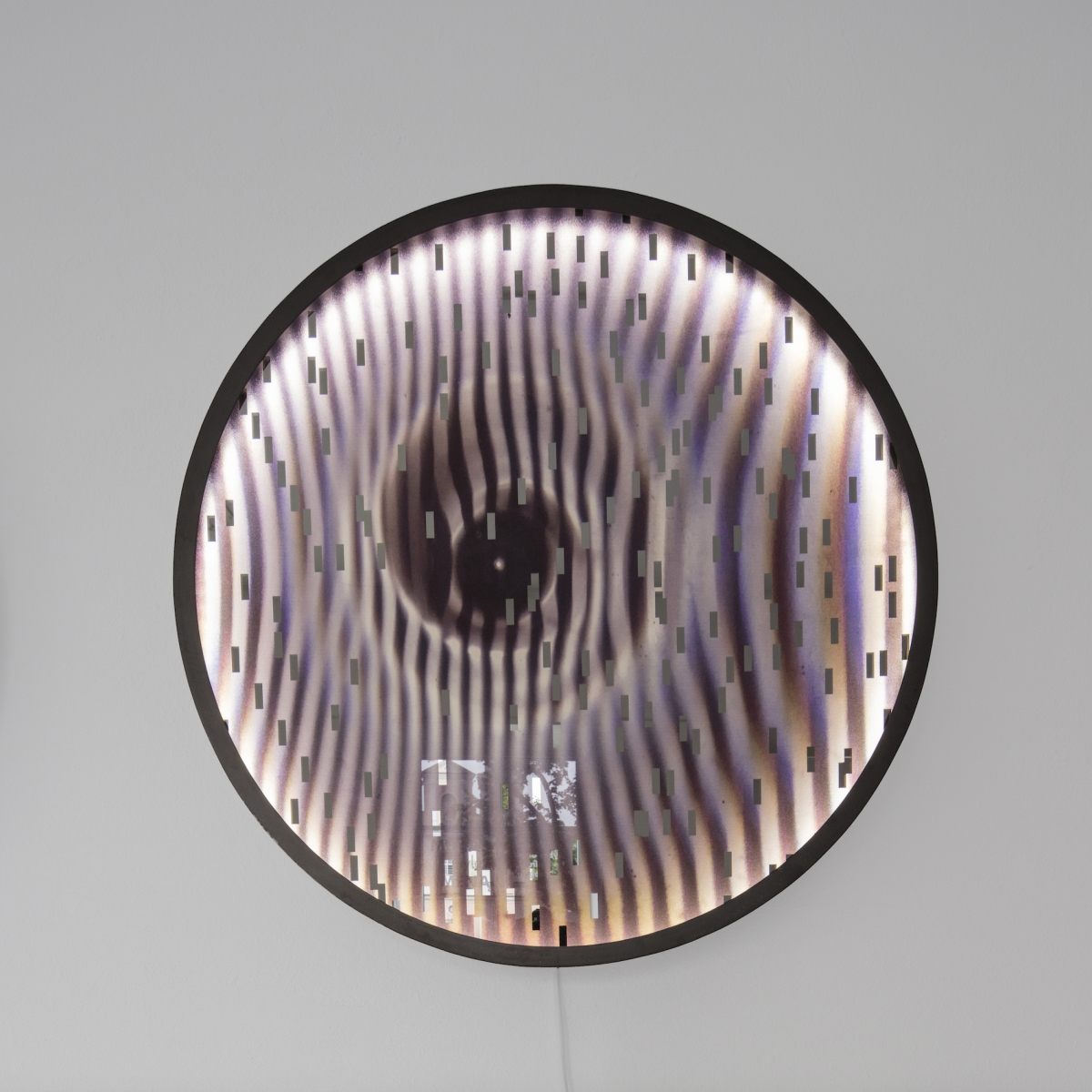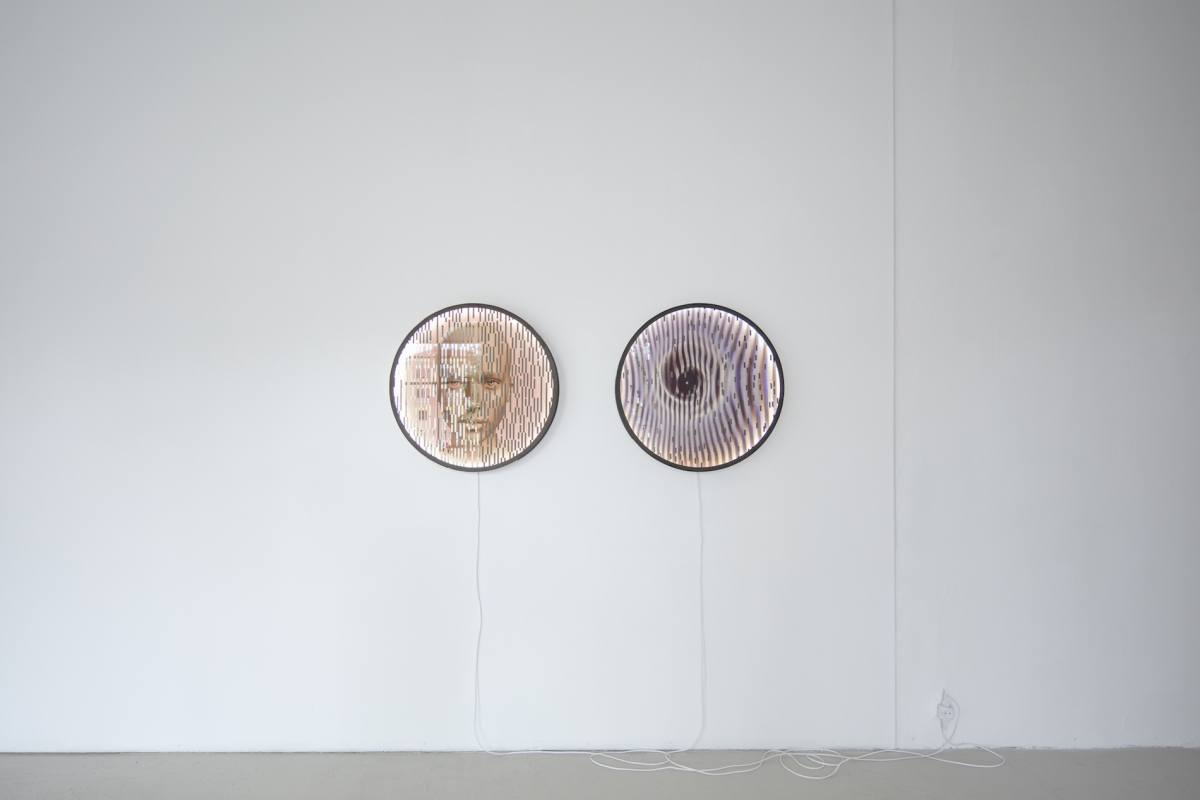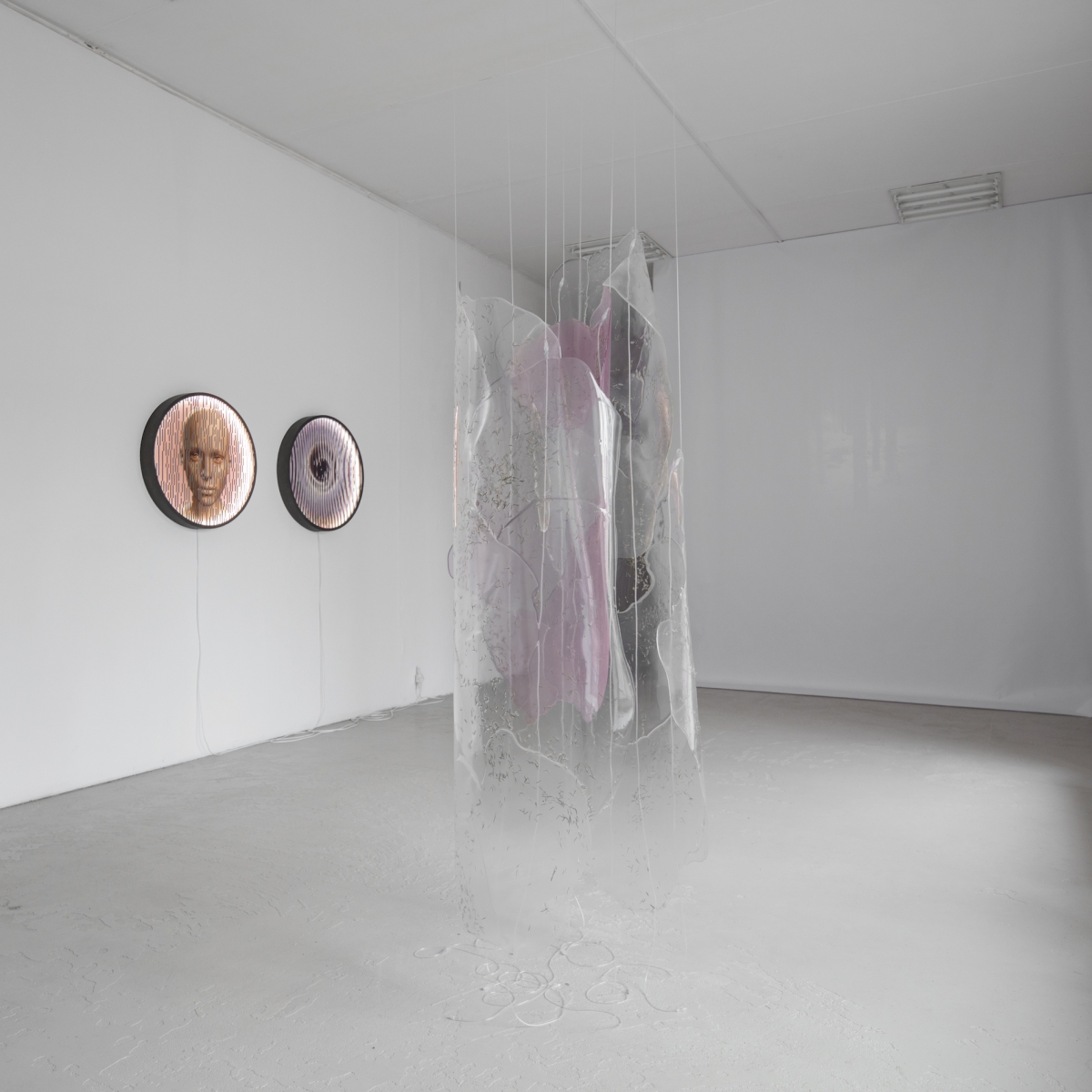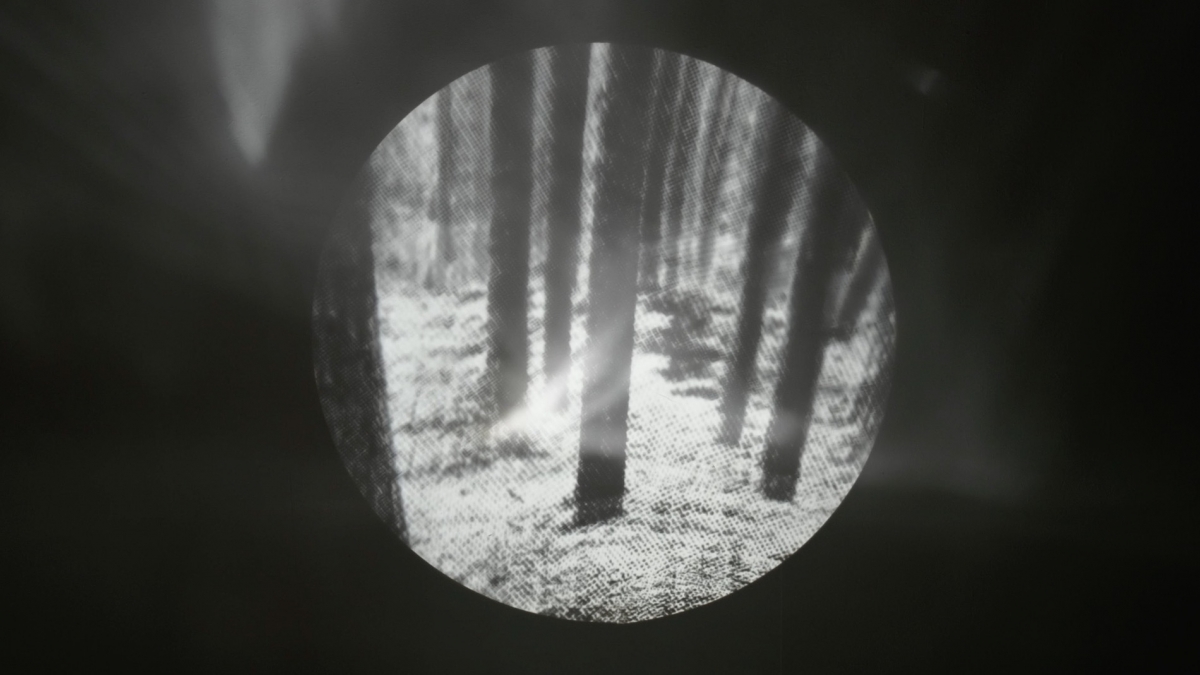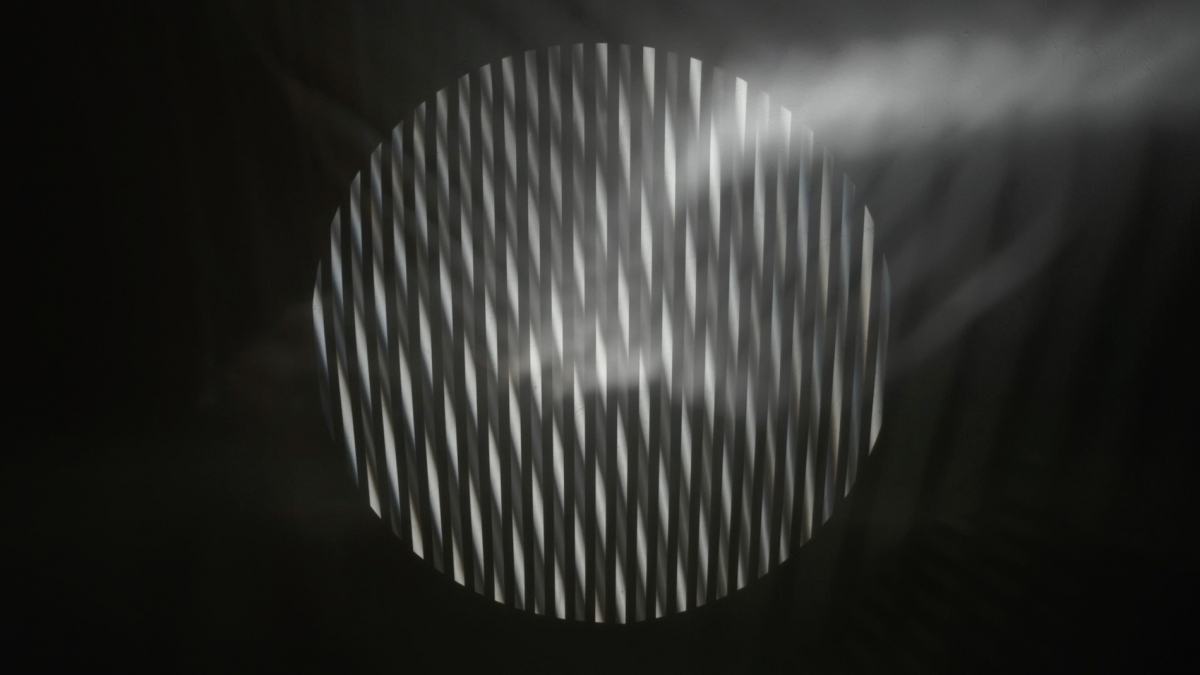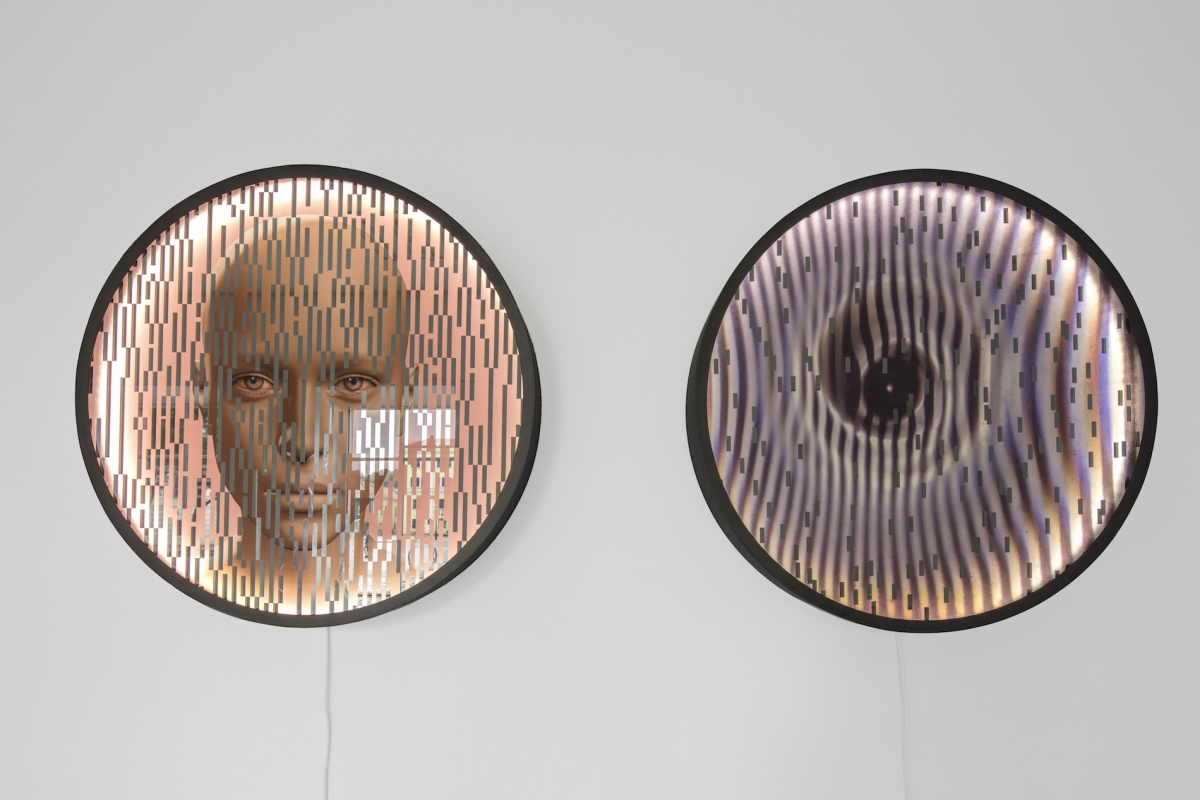The art critic Evelina Januškaitė and the artist Julija Pociūtė have a virtual conversation about the exhibition ‘The Dazzled Eye Lost Its Speech’ (Meno Parkas gallery, 2020).
ON CREATIVE WORK AND REALITY
EJ: In the latest exhibition, the interdisciplinary artist Julija Pociūtė continues her previous artistic research, in which physical expression consists of various reflective and (non)capturing surfaces in persuasively manipulating ephemeral images to attract the viewer’s gaze. Using reflective screens[1] that spontaneously reproduce the visibility of the surroundings, the artist considers interactions between the personal and the collective memory, the illusion of time, and the relationship between reality and fiction, the object and its reflection. Thanks to its physical properties and the symbolic charge of reflection, the author activates the individual memory of the perceivers, and, by manipulating their gaze, evokes an excessive experience of reality. Reflection, in Julija’s oeuvre, acts as an ephemeral and ever-(re)created image, whose spontaneous and fading experience reduces the visible and perceived reality, while the mirror surface establishes and sharpens in the reflection a false, fictitious, simulated reality.
By using a synthesis of reflection and light, but also the canonical composition of sounds, the artist presents some illuminated and sculptural objects, and a video work in her solo exhibition ‘The Dazzled Eye Lost Its Speech’, where she multiplies and (re)constructs reality coordinates, and complements and enhances our sensory experience. What becomes the most important feature is the overlap of the experienced realities and the spaces between the different registers of time that open up to the viewer’s perception: as the frameworks of the experience of temporality overlay each other, a state of uncertainty and vigilance arises. The memory, archiving the past in the form of memories, the spontaneous and ephemeral present experience and anxiety about the expansion of virtuality into our consciousness and experiential territory, articulate Julija Pociūtė’s fundamental quest for a vector of personal time in this reality, which has been entangled in networks and become fiction.
Julija, how does this exhibition extend and complement your creative reality? Why is it still relevant to you to rethink fundamental binary oppositions? Does the exhibition function as a stand-alone creative experiment of recent times, incorporating additional sound elements, or is it a still more generalising outcome of your broader creative context? What have you experienced and realised in creating these works?
JP: The exhibition continues previously caught-up research, where I am interested in the visuality experience, consisting of image capturing and perception, along with the intermediate states of mind experience that arises in this relationship, closely related to the phenomenon of memory retention and variability, as a particular diapason of memory visuals. I wanted to refine the simplified visual resolution, which would focus on the repetitive element: specific layers of the image. I delved into each layer as a separate element of the whole, while creating an indivisible whole.
What is relevant to me is the contradictions and contemplative questions born inside certain dualities, which allow us to consider the structure of environmental experience. Like every stage of creation, even bringing up different themes, it is part of an ongoing creative process. Certain images, by moving over from a previous exhibition, refer to an endless creative process that is stopped and placed in space at some point. My discovery in this exhibition was that kind of intuitive sharing of the same idea between different media, thus emphasising the subtlety of the chosen means of expression, such as plastic, light, video media or glass elements, despite their different uses and applications.
 ILLUMINATED OBJECTS
ILLUMINATED OBJECTS
EJ: Physically, the exhibition consists of circular-shaped light image objects shown on the walls. The screen of each one of them opens a dual viewing trajectory: the image is divided into rhythmic verticals of equal width, some of which are mirror images, and some are fragmented photographs. By balancing between the reflected present (reality), the depicted past (memory), and future projections (imaginary) arising from their interactions, Julija challenges the viewer’s consciousness, disrupting his/her visual alertness, and at the same time making him/her engage in dialectics of real and false that the artworks reconsider.
The first object Forest (2020) borrows an image from the author’s previous installation (2017) and video work In The Forest (2018). When viewed from a distance, a photographic image of a forest area is visible, although part of the photograph has been removed from our field of vision by replacing it with a reflective surface; the gaze fills in the missing areas of the image, and allows it to be perceived holistically. What interacts in the artwork is a visually recalled past experience, digitally captured and transferred to a new image register, and a spontaneous present that mimics reality as it is experienced. As you get closer to the screen, your gaze focuses on its own engaging and divided reflection in the surface of the mirror. Due to the live streaming surface, the art object is an active, catalysing part of the installation: the representation of one’s own image in the artwork acquires an aesthetic basis, and questions the problematics of ‘I am the other I’, the ‘I am not me’ beyond the screen.
On the surface of the mirror, the image is temporary, and temporality reduces the imitation of reality to a momentary impression. Julija Pociūtė’s immersive installations function as visual screens of time intermissions, in which the parameters of changing reality are entrapped on the momentarily non-capturing surface of the image. These mimetic (reflective and repetitive) artworks become continuations of the present (experience of time) and reality (representation) in time, forms of external representation that establish change and intangibility, which make up the bulk of our world-view, overflowing with images, and hide reality itself under various reflections and images.
The aspect of expansive digitisation of modernity in Julija’s exhibition unfolds in the work The Dazzled Eye Lost Its Speech (2020), where we see a portrait of a fictional woman, created by computer 3D modelling, between strips of mirror. Visually, it is reminiscent of the iconographic ideal, often cultivated in today’s media, which acquires features of the visual expression of artificial intelligence that is virtually communicating in real time. The symmetrical structure of the face allows us to imagine the visible image as an artificial representative aspiration, which we are spammed by the cult of the image of an ‘ideal’ but fake, falsified ‘perfect world’. It contributes strongly to the transformation of our visually crowded world-view into a fictitious simulation of reality.
This subject of the exhibition refers to the insertion of image producers and consumers into virtual matrices and social networks, where, in constructing our imaginary perfection, we distort the relationship between reality and repetition, and turn the created illusory image into an object of worship. The synchronisation of the gaze with the ideality created by the algorithms and the visible surface reflecting its own image immerses the present experience in the digitised space, and makes us reconsider: how intensely will we engage in the interactions of these overlapping realities? Will we still be able to sense the thin boundary between the phenomenological being here and the represented reality beyond the screen? Without seeking an unambiguous answer to these questions of modernity, without facing one or another side of contradictions, the artist suggestively reflects the current state of a divided, split personality, setting the tone for the autonomous interweaving of these phenomena by each perceiver.
The third object in the same cycle, Depth (2020), depicts a rather abstract fragment that can be associated with the eye, which has direct connotations with the rethinking of vision and visual experience, but can also resemble a black hole that takes in not just images (and, at the same time, the reflection of the viewer himself/herself), but also the light which cannot escape from it. The rotating spiral universe, the dynamics of a stationary image on the screen, optically creating the illusion that the gaze dives in and succumbs to being drawn into the visible whirlpool: here, Julija captures the visual shift from the flow of static and captured images to the stream of virtual, short-lived and ephemeral pictures. In order to satisfy the lust for the effigy, the viewer must find a certain point of view at which the visual plane opens up as illusory freedom of choice: I can see the overall face of an artificial woman reminiscent of the female robot Sofia, but I can focus on my own uncaptured image in mirrored parts of the screen. Due to reflective surfaces and various repeating screens, the relationship between reality and its imitation reaches a dangerous level when it comes to doubt what is shown, and one begins to believe in what is seen. This is how the scopophilic (in)sight phenomenon emerges, which symbolises both the gaze dissecting several layers of different realities (phenomenological-experiential and virtual-fictitious) actualised by Julija, and the penetration of the digital image into our field of vision, with its insertion into our states of going through reality.
In this way, Julija Pociūtė’s works evoke an introspective state in the viewer, which forms against the reflective and non-capturing surface of the image, thanks to which the temporal experience of the seeing agent builds itself, briefly suspended in the ever-passing present. In this cycle of illuminated objects, the capturing of the past and the reflection of the present overlap on a single screen, and the viewer’s gaze becomes the main tool for sensing the abruptly disappearing, (un)transparent reflection of the present time.
Julija, you used to focus on the interaction of visual experience and memory, the real or illusory image, and also, your work contained fundamental reflections on life and death, personal memories, and the collective consciousness. This time, the context of the exhibition expands: there is no more emphasis placed on one guideline of binary oppositions, and a loop appears, with no way out and no end, but rather with a procedural flow of time compressing them into one singular point. The exhibition rethinks it by sharpening the continuity of time: starting with the image of memories and real recorded experience, you leave the exhibition unfinished, autonomous for everyone’s rhetoric of future reality, where experiential states of mind are virtualised, depersonalised, and translated into universal algorithmic register media. What do you think the reality of the future is? How does your personal present shape itself, and how do you envision it in future projections? Does one have to come to terms with the inevitability of an expansively convincing future?
JP: In my opinion, the reality of the future will be inseparable from the illusory perception of reality, where the layers of reflections, visualisations and virtuality should interact; they will intertwine with each other to disturb the fundamental moment of existence, immersed in the great noise of the surroundings. The phases of human evolution inevitably bring different experiences and feelings of the time, with elements of anxiety prevailing in them, but at the same time, another reality and other methods emerge that strengthen our vigilance to exist under precisely these conditions. The greatest ‘luxury’ in futuristic films is considered to be nature, the purity of the air, and naturalness, and this is perceived by the principle of contrast: a fresh breath of air in a polluted metropolitan environment, or clean water in water that is drowning in rubbish.
TRANSPARENCY
EJ: In the work Layers (2020), the transparency of matter, which is another material property relevant in Julija’s work, functions as a trap for reflections of light. The needles of the spruce tree stuck in liquid plastic symbolise the duration of time, and reinforce the narrative of extinction, the temporality of being. The combination of artificial resins and natural elements in the artwork highlights the concepts of reality and artificiality, as well as their inseparability. The transparent and flexible material emphasises their fluidity and transparency in relation to the real environment, while the spontaneous and unfixable transparent shadow sharpens the impression of temporality and the space-specificity of the overlapping screens. Settled in the middle of space, the installation object acquires the status of a central figure; but, being transparent, it turns into an almost imperceptible sign, redrawing the perimeter of the neighbouring, but almost dissolved, ever-passing-present in the flow of time.
From the point of view of the philosopher David Hoy, who studies post-structuralism, there is no present, and temporality is a condition for the possibility of subjectivity. When the agent perceives himself/herself in the moment of experience, the experience is already over, and the present has turned into the past, or, as I have mentioned, the passing present. In this case, the present modality, as a phenomenon of experience, cannot exist in the time frame, because the now is always neutralising itself.
Julija, what is your relationship with the present? How can one calculate the duration of the existence of the past? When does the past begin and end? And how long does the present last, which is ever-passing? What are your insights (as a researcher) into the overlapping screens of realities (real/experiential vs. fictitious/representative)? Do their overlapping layers come into contact? Are there still always voids and cavities left unfilled with their time durations and materiality?
JP: Wow, so many fundamental questions, Evelina! I’d like to answer as follows: I only know that I don’t know … The moments of the present are like overlapping layers, flashing in the ‘liquid’ of time, where certain parts of this phenomenon dissolve, and others harden and remain in the body like indelible, fossilised stones, overgrown with new experiences. In this process, I am interested in the principle of memory operation, where certain moments remain in the memory, and others disappear without a trace. The present moment is captured by the senses, and perceived as changing matter, vibration, movement and stagnation in one. To me, your comparison of ‘realities as overlapping voids and cavities …’ sounds very nice … Now I imagine: what if we put together many transparent layers of emptiness, would they turn into more opaque material?
 REALITY TIME IN A VIDEO WORK
REALITY TIME IN A VIDEO WORK
EJ: The narrative of tonal vibration, as one of the latest objects of Julija’s research, thanks to the author’s penetration into its (un)materiality, becomes a medium of audial as well as a visual register, characterised by an organic tune that covers the entire exhibition space. Audio recording and playback, as well as video filming and review, are procedural steps; with minimal delay in the passing present, they visualise the interruption of time in space, and intervene in the viewer’s consciousness and field of vision/hearing.
In the video work The Dazzled Eye Lost Its Speech (2020), the visual screen is defined by a circular format, in this way as if combining it with the shape of luminous objects, while at the same time looking at the image on the screen through a doorway, viewfinder or binoculars. The chosen format is also symbolically reminiscent of a ‘vicious circle’ that cyclically repeats and returns to the same starting point, but each time does it differently, to an ever-different observing Self. All video works function by this principle, as the recorded content now has a directional connection with the past through its ‘presence in the medium’, which, again, creates the circumstances of duration in Julija’s exhibition. Postulating the concept of the era, Deleuze argues that the time-image is not in the present. The present is all that the image ‘represents’, but not the image itself. The image itself is a bundle of time relations from which the present emanates as a common multiplier, or as a common denominator. The image makes visible, and incorporates into the work, a relationship of time that cannot be reduced to the present.[2]
This video work was born without the use of computer effects or programs: the projector membrane is employed as a directional scheme to capture the interplay of light and reflections in time, manipulated by the artist’s hands. Indeed, film directing here is not the most appropriate word to describe the specifics of creative work; however, there is a great random, spontaneous process of broadcasting the ephemerality of light that the camera has managed to capture. Unlike other reflection objects created by Julija, this video film ‘picks up’ the reflections in the recorded image, so they can be reproduced and repeated, not just during the editing, but also every time that the work is viewed. In operating the excess of present images, reflection multiplies the perceived reality and amplifies it through the intensity of time. You can experience the artwork both by sight and by hearing: the shifting abstract images on the screen, like a kind of meditative theatre of light and shade, interacting with a space-piercing composition of canonical music, create an authentic experience awakened by capturing different senses, that of the contents of the past and the present moment, but also turning into an engaging and hypnotising reception of presentness.
Julija, this exhibition differs from your previous creative presentations, in that this time you complement the visual experience with an audio one. What does the integration of canonical music, which you borrowed from another author to complete your own work, mean to you? How does the sonic perception complement, transform, or give meaning to your confrontation of reality and illusion in the images? Audio and video recording captures a certain period of time, and, by assembling fragments of the past reality into a specific sequence, creates the former reality, but also asserts its duality in another time and space. What do the time interruptions mean to you? In this networked and fragmented world-view, increasingly referring to the unstable states and experiences of our reality, is the continuity of time and its experience possible?
JP: The vocal canon ‘The Dazzled Eye Lost Its Speech’ by Rytis Mažulis fascinated me with its minimalist musical composition, which captivates and overwhelms the listener. It is an infinite, spiral-shaped canon for four equal voices, where the voices move up and down in two circles joined together in a figure of eight. The sound of this canon has evoked associations with the tradition of archaic music, namely, the singing of Lithuanian polyphonic sutartinės, which I have practised for many years. The vibration of overlapping, dissonant voices experienced while singing sutartinės means to me the physical experience of vibration. If we unfold the canon principle in a visual manner, it would show an image of overlapping slides stacked on top of each other, with their layers creating an optical illusion.
Interruptions of time are like a slowed-down experience of the present, which is possible by experiencing profoundly the present moment, by feeling the full palette of its colours, sensations and tastes. This requires the training of one’s experiential awareness, allowing one to find oneself in an intensified present moment that pushes one out of the rotating spiral of time. At that moment, in the observation of one short flash, the continuity of experience can emerge, consisting of the experience of oneness with oneself and the surroundings, no matter how illusory they may seem.
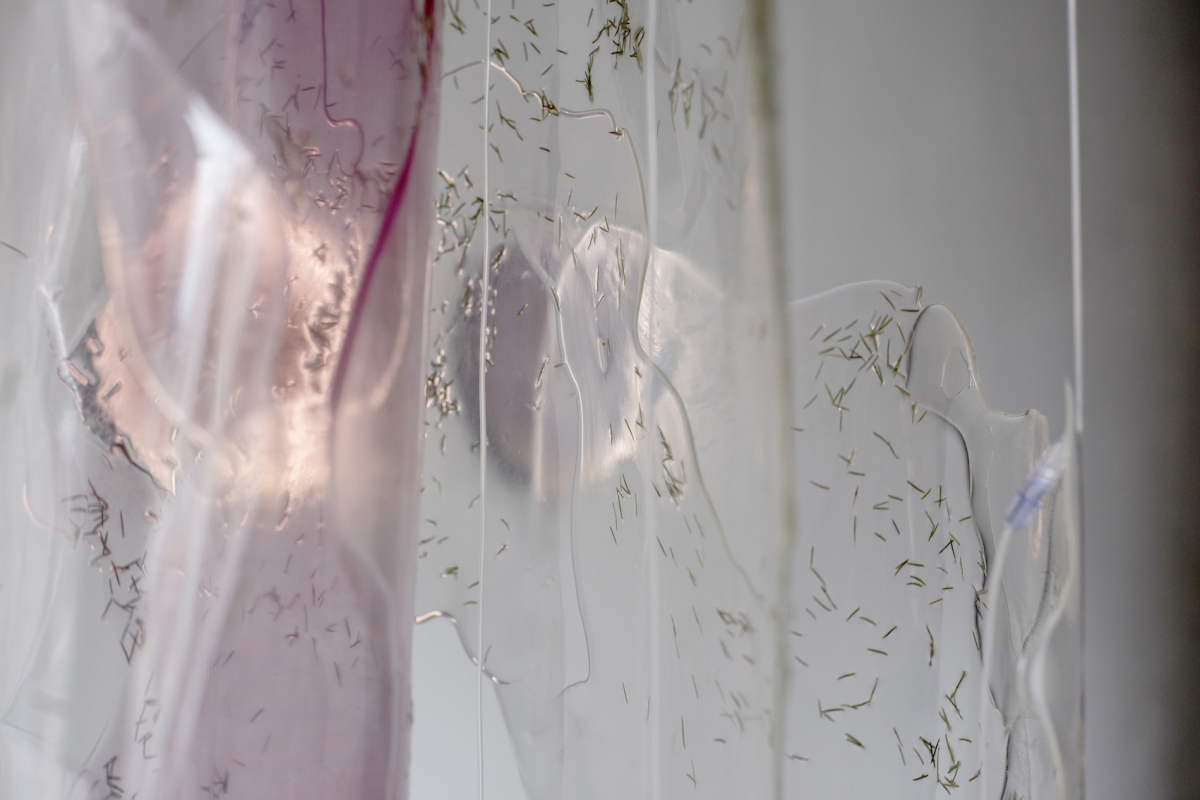 THE (UN-)IMAGINABLE END?
THE (UN-)IMAGINABLE END?
EJ: The very title of the exhibition contains the encoded spontaneous impression (the dazzle), the zone of vision activation (eye), and the lack (loss) of the voice (speech) that transmits sound. All of these components, interacting with the viewer’s personal experiences, memories and imagination, build an impalpable plane of experiencing space and time. The minimalistic music, the vibrations of overlapping sounds, fading reflections, ephemeral light, and the temporary experience of the viewer, the ‘dazzled eye lost its speech’, become a catalysing transmission of illusory memory and an ever-changing communication between the author and the perceiver. Julija’s oeuvre unfolds as fragmentary sequences of memory and experiences, in the process of which one can sense the narrative of decline; it considers the temporality of being experienced by the viewer, and actualises the question of the viewer as a visual object, as well as of his/her experience of reality through the mimetic and temporal reflection of oneself as the Other and the surroundings.
In her oeuvre, Julija Pociūtė ‘employs’ the reflective surface as a kind of screen for the transitory contents of the memory and the imagination, the constantly changing and disappearing visibility. With the help of the perceiver’s vision as the main tool for unlocking the artwork, she enacts the viewer’s individual memory and consciousness as a major and autonomous spot for the (self-)creating of artistic images, or repetitions.
By exploring the interplay of photography, reflections, performative images and sounds, the artist captures the temporality of video and sound, and allows everyone to immerse themselves in an autonomous state of listening to the space of the work, thus capturing the condensed multi-layered reality. By turning images into a reproduction of digitised reality, Julija Pociūtė constructs an illusory memory, which acts in her work as a constantly self-recreating medium for (dis)capturing the experiences of the ever-passing present filled with flashes of sounds and images. By exploring the interplay of photography, reflections, and performative images and sounds, the artist captures the temporality of video and sound, and allows everyone to immerse themselves in an autonomous state of listening to the space of the artwork, thus building a condensed multi-layered reality. ‘The Dazzled Eye Lost Its Speech’ exhibition is an irritating opening, in which the volatile experiences of time expand our perception of the present.
[1] Here, the term screen is used not so much in the conventional way, but in a more conceptual and phenomenological sense. The screen in this case refers to the plane facing the viewer’s gaze, and absorbing, reflecting or broadcasting the images.
[2] Gilles Deleuze, ‘The Brain is the Screen’, in: Lapoujade D. (ed.), Two Regimes of Madness. Gilles Deleuze Texts and Interviews 1975-1995, Semiotext(e), pp. 282-291.




